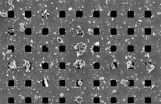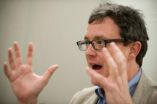(Press-News.org) COLUMBUS, Ohio – Researchers recently isolated 63 unique dust particles from their laboratory – and that's just the beginning.
The chemists were testing a new kind of sensor when dust got stuck inside it, and they discovered that they could measure the composition of single dust particles.
In a recent issue of The Journal of Physical Chemistry C, they describe how the discovery could aid the study respiratory diseases caused by airborne particles.
Most dust is natural in origin, explained James Coe, professor of chemistry at Ohio State University. The 63 particles they identified were mainly irregular blobs containing bits of many different ingredients.
The most common ingredient of the dust particles was organic matter, Coe said. "Organic" indicates some kind of plant or animal material, though the researchers can't yet say precisely what kinds of organic matter they found. They are about to do an in-depth analysis to find out.
Quartz was the second-most common ingredient. Both quartz and organic matter were found in more than half of the dust particles the researchers classified. Man-made chemicals from air pollution, fertilizers, and construction materials were also present in small amounts.
"In that way, a single dust particle is like a snapshot of mankind's impact on the environment," Coe said.
Scientists have had some difficulty getting precise measurements of dust composition, in part because standard techniques involve studying dust in bulk quantities rather than individual particles.
Nowhere is dust composition more important than in public health, where some airborne particulates have been linked to diseases. Coe cited silica dust from mining operations, which causes a lung disease called silicosis.
The patented sensor that Coe's team was testing – a type of metal mesh that transmits infrared light through materials caught in the holes – is ideal for picking up minute details in the composition of single dust grains.
"We can separate particles by size to isolate the ones that are small enough to get into people's lungs, and look at them in detail," he added.
Coe didn't set out to study dust. He and his team invented the metal mesh sensor in 2003, and discovered that they could use it to create surface plasmons – mixtures of conducting electrons and photons. The effect boosts the intensity of light passing through microscopic holes in the mesh, and lets scientists record a detailed infrared light spectrum. Any material stuck in the holes will leave a unique signature on the spectrum, so the sensor can be used to identify the chemicals in microscopic samples.
Early this year, the researchers were testing how light flows through the sensor, and they coated the mesh with a ring of tiny latex spheres to take a baseline measurement. The result should have been a spectrum unique to latex, but instead the spectrum carried the signature of several common minerals due to a single dust particle that had gotten inside the sensor – most likely from the laboratory air.
Coe launched a contest among his students to see who would be the first to take an infrared spectrum of a single dust particle – and an electron microscope image of the same particle. The winner got a free lunch and the chance to name the particle for publication.
Matthew McCormack, then an honors undergraduate student in the lab, won the contest and named the dust particle after his dog, Abby. His study of the particle formed the basis for his honors thesis, and the data has since been used by Coe and other members of the team in publications and presentations.
In subsequent tests, the students were able to isolate and study 63 individual dust particles from the air of their laboratory. The spectra they obtained with the sensor were free of scattering effects and stronger than expected.
The result is a library of common dust components from the lab. Forty of the particles (63 percent) contained organic material. The most common mineral was quartz, which was present in 34 (54 percent) of the particles, followed by carbonates (17 particles, or 27 percent), and gypsum (14 particles, or 22 percent).
Currently, Coe and his team are constructing computer algorithms to better analyze the mineral components and reveal details about the organic components.
A library of common dust components would be useful for many areas of science, he said.
Eventually, researchers in public health could use the sensor as a laboratory tool to analyze dust particles. It could also enable studies in astronomy, geology, environmental science, and atmospheric science.
INFORMATION:
McCormack is a co-author on the paper, along with Katherine Cilwa, now a postdoctoral researcher in chemistry at the University of Michigan; Michelle Lew, now a doctoral student in chemistry at Indiana University; Christophe Robitaille, now in medical school at the University of Chicago; Lloyd Corwin, a former Ohio State undergraduate student in nuclear engineering; and Marvin Malone, a current doctoral student in Coe's laboratory.
This research was supported by the National Science Foundation.
Contact: James Coe, (614) 292-9489; Coe.1@osu.edu
Written by Pam Frost Gorder, (614) 292-9475; Gorder.1@osu.edu
1 room -- 63 different dust particles? Researchers aim to build dust library
2011-10-06
ELSE PRESS RELEASES FROM THIS DATE:
Eminent Domain and the Government's Right to Take Away Your Property
2011-10-06
Property rights are one of the essential tenets of our society. According to one California eminent domain attorney, property owners are entitled to use their property how they see fit within the bounds of the law. However, there are instances where the government is entitled to infringe upon one's property to support the greater good of the community. This is called eminent domain.
Under the principle of eminent domain, it is the government's right to "take" private property for public use. When a "taking" occurs, a municipality must pay fair market ...
Managing Medical Debt Through Bankruptcy
2011-10-06
The sluggish economy is not only affecting job growth in the United States, it is also spurring more debt due to medical expenses. According to study conducted by the Commonwealth Fund, 57 percent of workers who lost jobs that previously had health insurance have become uninsured. This creates two problems for those who become sick: Not only do they no longer have health insurance to defray medical expenses, they also lack the income to pay such costs out of pocket.
The Commonwealth Fund also found that debt collection companies contacted 30 million Americans in 2010 ...
MIT research: Career path closed, must take detour
2011-10-06
CAMBRIDGE, Mass. -- Technology firms frequently require workers to sign non-compete agreements, which typically bar their employees from joining rival companies for one to two years. For firms, the agreements keep workers from taking the knowledge and skills they have acquired and using them to help a rival.
But a new study of more than 1,000 engineers, conducted by an MIT professor, shows that non-compete agreements come with a high cost for employees: When those workers do shift jobs, roughly one-third of them end up leaving their chosen industry altogether, often ...
Spousal Support Reform Is Not As Good As It Looks on Paper
2011-10-06
Over the past few years, a movement to reform spousal support (called "alimony" and "spousal maintenance" in some states) has been making its way across the nation. Spousal support in its traditional form consists of the money-earning spouse providing financial support to the other spouse after a divorce. The amount of spousal support can be agreed upon or calculated based on the earning spouse's ability to pay and the needs of the non-earning spouse.
Because of changing times -- in which more and more wives and mothers work outside the home -- many ...
Report reveals economic, social costs of hunger in America
2011-10-06
The Great Recession and the currently tepid economic recovery swelled the ranks of American households confronting hunger and food insecurity by 30 percent. In 2010 48.8 million Americans lived in food insecure households, meaning they were hungry or faced food insecurity at some point during the year. That's 12 million more people than faced hunger in 2007, before the recession, and represents 16.1 percent of the U.S. population.
Yet hunger is not readily seen in America. We see neither newscasts showing small American children with distended bellies nor legions of thin, ...
Collectivism and bribery
2011-10-06
Why are some places more prone to bribery and corruption than others? Part of the answer seems to be the level of collective feeling in a society, according to research by Pankaj Aggarwal, University of Toronto Scarborough (UTSC) professor of marketing in the Department of Management, and Nina Mazar, University of Toronto professor of marketing.
Aggarwal and Mazar discovered that people in more collectivist cultures – in which individuals see themselves as interdependent and as part of a larger society – are more likely to offer bribes than people from more individualistic ...
Saving the Social Security Trust Fund from Washington Politicians
2011-10-06
Before Congress passed a budget deal in early August 2011, President Obama expressed concern in a televised speech that the federal government would be unable to pay Social Security benefits without a long-term agreement on the budget. Others in Washington, including President Obama's budget director Jack Lew and Senate majority leader Harry Reid, disputed the president's assertion, maintaining that Social Security is a self-funding program with a $2.6 trillion trust fund that is capable of funding benefit payments for the next 25 years. How could politicians deliver such ...
Zinc's role in the brain
2011-10-06
Zinc plays a critical role in regulating how neurons communicate with one another, and could affect how memories form and how we learn. The new research, in the current issue of Neuron, was authored by Xiao-an Zhang, now a chemistry professor at the University of Toronto Scarborough (UTSC), and colleagues at MIT and Duke University.
Researchers have been trying to pin down the role of zinc in the brain for more than fifty years, ever since scientists found high concentrations of the chemical in synaptic vesicles, a portion of the neuron that stores neurotransmitters. ...
FDG-PET appears promising for predicting prognosis of patients with inoperable NSCLC
2011-10-06
Miami Beach, Fla. — The prognosis for patients with stage II and III inoperable non-small cell lung cancer (NSCLC) is poor, with only about 15 percent of patients surviving at five years post-treatment for the disease. While new treatment strategies are being intensely studied, timely assessment of their efficacy has proven difficult. In a presentation today, Mitchell Machtay, MD, principal investigator of the ACRIN 6668/RTOG 0235 trial and RTOG deputy chair, reported the that post-treatment F-18 fluorodeoxyglucose-positron emission tomography (FDG-PET) scans show promise ...
Research sheds light on origins of greatness
2011-10-06
EAST LANSING, Mich. -- What makes people great? Popular theorists such as the New Yorker's Malcolm Gladwell and the New York Times' David Brooks argue that intelligence plays a role -- but only up to a point. Beyond that, they say, it's practice, practice, practice.
Zach Hambrick agrees with the practice argument -- imagine where Bill Gates would be if he hadn't honed his programming skills, after all -- but the Michigan State University scientist takes exception to the view that intelligence plays no role in determining excellence.
In a provocative new paper, Hambrick ...

